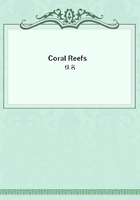
第14章
I will here give a sketch of the general form and structure of the many atolls and atoll-formed reefs which occur in the Pacific and Indian Oceans, comparing them with Keeling atoll. The Maldiva atolls and the Great Chagos Bank differ in so many respects, that I shall devote to them, besides occasional references, a third section of this chapter. Keeling atoll may be considered as of moderate dimensions and of regular form. Of the thirty-two islands surveyed by Captain Beechey in the Low Archipelago, the longest was found to be thirty miles, and the shortest less than a mile; but Vliegen atoll, situated in another part of the same group, appears to be sixty miles long and twenty broad. Most of the atolls in this group are of an elongated form; thus Bow Island is thirty miles in length, and on an average only six in width (See Figure 4, Plate I.), and Clermont Tonnere has nearly the same proportions. In the Marshall Archipelago (the Ralick and Radack group of Kotzebue) several of the atolls are more than thirty miles in length, and Rimsky Korsacoff is fifty-four long, and twenty wide, at the broadest part of its irregular outline. Most of the atolls in the Maldiva Archipelago are of great size, one of them (which, however, bears a double name) measured in a medial and slightly curved line, is no less than eighty-eight geographical miles long, its greatest width being under twenty, and its least only nine and a half miles. Some atolls have spurs projecting from them; and in the Marshall group there are atolls united together by linear reefs, for instance Menchikoff Island (See Figure 3, Plate II.), which is sixty miles in length, and consists of three loops tied together. In far the greater number of cases an atoll consists of a simple elongated ring, with its outline moderately regular.
The average width of the annular wreath may be taken as about a quarter of a mile. Captain Beechey (Beechey's "Voyage to the Pacific and Beering's Straits," chapter viii.) says that in the atolls of the Low Archipelago it exceeded in no instance half a mile. The description given of the structure and proportional dimensions of the reef and islets of Keeling atoll, appears to apply perfectly to nearly all the atolls in the Pacific and Indian Oceans. The islets are first formed some way back either on the projecting points of the reef, especially if its form be angular, or on the sides of the main entrances into the lagoon--that is in both cases, on points where the breakers can act during gales of wind in somewhat different directions, so that the matter thrown up from one side may accumulate against that before thrown up from another. In Lutke's chart of the Caroline atolls, we see many instances of the former case; and the occurrence of islets, as if placed for beacons, on the points where there is a gateway or breach through the reef, has been noticed by several authors. There are some atoll-formed reefs, rising to the surface of the sea and partly dry at low water, on which from some cause islets have never been formed; and there are others on which they have been formed, but have subsequently been worn away. In atolls of small dimensions the islets frequently become united into a single horse-shoe or ring-formed strip; but Diego Garcia, although an atoll of considerable size, being thirteen miles and a half in length, has its lagoon entirely surrounded, except at the northern end, by a belt of land, on an average a third of a mile in width.
To show how small the total area of the annular reef and the land is in islands of this class, I may quote a remark from the voyage of Lutke, namely, that if the forty-three rings, or atolls, in the Caroline Archipelago, were put one within another, and over a steeple in the centre of St. Petersburg, the whole world would not cover that city and its suburbs.
The form of the bottom off Keeling atoll, which gradually slopes to about twenty fathoms at the distance of between one and two hundred yards from the edge of the reef, and then plunges at an angle of 45 deg into unfathomable depths, is exactly the same (The form of the bottom round the Marshall atolls in the Northern Pacific is probably similar: Kotzebue ("First Voyage," volume ii., page 16) says: "We had at a small distance from the reef, forty fathoms depth, which increased a little further so much that we could find no bottom.") with that of the sections of the atolls in the Low Archipelago given by Captain Beechey. The nature, however, of the bottom seems to differ, for this officer (I must be permitted to express my obligation to Captain Beechey, for the very kind manner in which he has given me information on several points, and to own the great assistance I have derived from his excellent published work.) informs me that all the soundings, even the deepest, were on coral, but he does not know whether dead or alive. The slope round Christmas atoll (Lat.
1 deg 4' N., 157 deg 45' W.), described by Cook (Cook's "Third Voyage," volume ii., chapter 10.), is considerably less, at about half a mile from the edge of the reef, the average depth was about fourteen fathoms on a fine sandy bottom, and at a mile, only between twenty and forty fathoms.